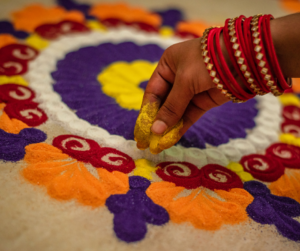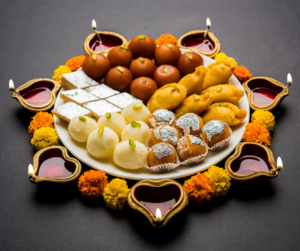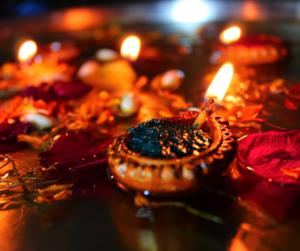Light on the darkest night
Celebrated to coincide with the darkest night of the lunar month of Kartik in either late October or early November, Deepawali or Diwali is the Hindu New Year’s Day. It is the biggest and brightest of all Hindu festivals and will be marked this year on Sunday 12 November with four days of festivities to illuminate countries and communities around the world.
Candles or tiny clay pots with wicks and oil spread light and joy around homes, families exchange gifts and share a special dinner with relatives and friends.
Four days of festivities
Each day of Diwali reflects a different tradition while sharing a powerful sense of the value of goodness, virtue, life, and happiness. The four days are preceded by Dhanteras – the first day, this year on Friday 10 November – which represents the date of the birth of Mata Laxmi, the goddess of wealth and fortune.
Choti Diwali is the second day and is recognised as the day on which Lord Shri Krishna destroyed the demon Narakasur. The day starts with a holy bath and fresh clothing to execute the morning’s religious ceremonies, after which the festivities begin.
Rangoli – an art form involving beautiful, vibrant patterns often formed from powders, sand, stones, and coloured petals – are placed in front of doors to embrace joy and keep evil spirits at bay.

Diwali’s third day is called Lakshmi or Kali Puja. It is regarded as Diwali’s major eve and is the root of the nickname ‘Festival of Lights’. All around are diyas, kandil and colourful lights to brighten this, the darkest day of the lunar month.
Often there are fireworks displays and people give Diwali sweets to their neighbours. Traditional foods eaten at Diwali include karanji (a Maharashtrian fried semolina dumpling), savoury samosas and pakoras, and sweets such as laddoos and gulab jamun.

Govardhan Puja is the fourth day, upon which Lora Krishna conquered Indra. It is celebrated with great passion and excitement.
On the fifth day, known as Bhai Dooj or Vishwakarma Puja, siblings strengthen their relationships by sharing their affection for one another. In some countries such as Fiji, India, Mauritius, Pakistan and Sri Lanka, it is an official holiday.
Rama and Sita
Diwali commemorates Lord Rama’s return from exile, along with his wife, Sita, which culminated in the vanquishing of the demon-king Ravana. In celebration of their safe return, the people of Ayodhya, capital of Rama, illuminated the kingdom with earthen diyas (oil lamps) and bursts of firecrackers.

Diwali differences
The stories and traditions of Diwali differ around the world. Where many mark the return of Rama and Sita, in Bengal the festival is dedicated to the worship of Mother Kali, the dark goddess of strength.
Hindu households also worship Ganesha, the elephant-headed god of auspiciousness and wisdom. Meanwhile, in Jainism, Deepawali marks the event of Lord Mahavira attaining the eternal bliss of ‘nirvana’.
Whatever the rituals of individual households, regions or communities, all have a significance and a story to tell. All demonstrate the ultimate respect for the gods, who in return ensure health, wealth, knowledge, peace and prosperity.
Wishing our alumni and supporters a safe, peaceful and beautiful Diwali!
Words by Anna Stephenson
Images by Amrita Rahman
With special thanks to Meagan Neves, President of the BAME Students Network, University of St Andrews
Find out more about the information in this article and about Diwali at:
‘Calendar of Religious Festivals: July 2022 to December 2023’, The Shap Calendar Group, http://www.shapcalendar.org.uk/calendar.html
‘Diwali – Festival of Lights’, National Geographic, https://www.youtube.com/watch?v=HrrW3rO51ak
‘What are the 5 days of Diwali in India 2023?’, Times Property, https://timesproperty.com/news/post/5-days-of-diwali-2023-in-india-blid3197#2
‘Rangoli’, Cultural India, https://www.culturalindia.net/indian-art/rangoli/index.html
‘Top 10 Diwali foods to try’, Asia Highlights, https://www.asiahighlights.com/india/top-diwali-foods
‘The Festival of “Deepavali” as Marks of Tradition and Identity for Working, Married Hindu Women: Continuity and Change’ Sheila Chirkut, Journal for the Study of Religion, Vol.20, No.1 (2007), https://www-jstor-org.ezproxy.st-andrews.ac.uk/stable/1258790?searchText=diwali+rama+and+sita&searchUri=%2Faction%2FdoBasicSearch%3FQuery%3Ddiwali%2Brama%2Band%2Bsita&ab_segments=0%2Fbasic_search_gsv2%2Fcontrol&refreqid=fastly-default%3A6e5ec284759abae3daaadc772f625f06&seq=4